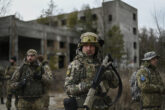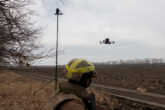August 27, 2020
A Strategy for Competition
Note: This paper offers a counterpoint to another in this series, “Defining DoD’s Role in Gray Zone Competition,” by Jim Mitre and Andre Gellerman.
The Bottom Line
- The next National Defense Strategy (NDS) must do much more than deter war. A state that competes successfully sets the terms of international life to suit its interests and convinces other actors to do more of what it wants, at the times of its choosing, in the ways that it likes. Deterring high-end conflict, even through overmatch, does not produce these outcomes.
- The Department of Defense (DoD) needs a strategy for competition that persuades friends and coerces adversaries. The new NDS should be guided by clearly defined regional priorities, and DoD should structure its forces to assure and enable friends, discourage adversaries from challenging U.S. interests, and respond rapidly and effectively to challenges that do arise.
Introduction
Competition in international political life is not new—it just seems so to some because the post–Cold War United States accommodated itself to the idea that great power politics were over.1 During the decades following the Cold War, the United States prospered at home and was unmatched militarily anywhere. It therefore did not behave as though it were competing for global influence; it simply assumed it had it.
This shifted during the Obama administration and then changed definitively in 2017, when the National Security Strategy and then the 2018 National Defense Strategy codified China and Russia as near–peer competitors. Deterring high-end conflict was instantiated as the Department’s primary objective in great power competition, with military overmatch subsequently identified by many in the defense community as the means necessary to achieve it.2
A strategy designed primarily to deter war, however, is ill-suited to meet the demands of competition. To compete successfully, DoD instead needs a strategy that uses its military strength to persuade friends and, when necessary, coerce rivals.
DoD’s Strategy Must Do Much More than Deter War
For the United States to compete successfully, the Department of Defense must do considerably more than deter war. Competition is the work of establishing the rules of international behavior, convincing as many actors to follow them as much of the time as possible, and incentivizing compliance and penalizing defiance so that the rules remain intact. The United States, in other words, must use its armed forces to influence the conduct of others—to coerce them toward acceptable behaviors and away from those that run counter to U.S. interests.
A strategy designed primarily to deter war is ill-suited to meet the demands of competition.
Recent history demonstrates that a military highly capable of deterring war—indeed, through military overmatch—does not consistently produce these outcomes. Between 1991 and 2018, the United States used its overwhelmingly powerful military to make demands on other states’ behaviors in more than 100 instances. It successfully convinced those states to comply with its demands 50 percent of the time.3 Having unquestioned overmatch neither prevented challenges from arising nor did it produce a particularly good record of success.
China and Russia do not want to risk outright war with the United States, but they do want to set the terms of international political life to suit their interests, most especially in their respective regions. They therefore have challenged and will continue to challenge important U.S. interests below the threshold of war as a means of contesting and establishing an alternative to the United States as international rule-setter.4 Continuation of a strategy designed to win a war that everyone seeks to avoid not only is unlikely to change this behavior, but also is ahistorical and dangerous. It undervalues the concepts and activities of military coercion that are central to competing effectively, and it is financially risky: having been on the winning side of a nationally bankrupting arms race in the past does not guarantee a similar outcome in the future.
DoD Needs a Strategy Designed to Persuade and Coerce
The foundation of an effective new National Defense Strategy for competition is an understanding of the military not exclusively as a tool for deterring or prosecuting war, but rather as a political instrument that can be used independently or in concert with other elements of national power to shape the actions of other states. This is not a whole-of-government platitude, it is what will differentiate a successful strategy for competition from a failed one. The military must be prepared to be frequently called into action to defend and promote U.S. interests by coercing other states to change their conduct.
Some states may agree with the United States’ preferred rules of international behavior because they suit their own material and instrumental interests, or because they comport with their values. These states, however, still will have interests of their own that do not always align neatly with those of the United States. The United States, therefore, will need on occasion to wield influence by inducing their cooperation, whether through non-military means or through direct military assistance, foreign arms sales, or reassurance operations that demonstrate commitment to their security. This largely describes today’s relationships between the United States and its allies in Europe, Asia, and the Middle East.
The military must be prepared to be frequently called into action to defend and promote U.S. interests by coercing other states to change their conduct.
For all other states, the United States will need to wield influence with a firmer hand. The military is enormously flexible and, when used properly, is an effective tool with which to reduce uncertainty not only about U.S. capability but—often more importantly— about its commitment to a policy outcome.5 DoD has an indispensable role in signaling to others, not least to China and Russia, the international political actions that the United States can tolerate and those that it cannot, along with U.S. readiness to enforce those expectations.6
Recommendations
A U.S. force structure and posture suited for near–peer competition must both disincentivize opportunism by China and Russia and enable responsiveness when, inevitably, they test U.S. limits. A DoD strategy that is well-tuned to deter war and compete effectively will:
Maintain the minimum necessary strategic deterrent and forego development of destabilizing capabilities.
The United States should leave no room for confusion that its nuclear arsenal is defensive, not offensive, in nature. This means DoD should not invest in tactical nuclear weapons, nor should it pursue systems designed to defeat China’s or Russia’s strategic capabilities. U.S. missile defense should be closely circumscribed to defend theater assets and demonstrate to North Korea and Iran that they cannot hold the United States or its allies at risk.
Reduce forward presence and enhance mobility.
Current U.S. force posture is expensive fiscally and, often, politically.7 Reducing the U.S. footprint will not compromise its deterrent effect. Supporting allies’ development of local capabilities while retaining a more moderate U.S. presence tailored to enable rapid response will both provide a tripwire deterrent and facilitate action to confront challenges. In Europe this means working with NATO allies to improve infrastructure: the bridges, tunnels, road, and ports needed to move forces forward.8 In the U.S. Indo-Pacific Command it means resourcing adequately the individual services’ and joint sustainment capabilities, and conducting exercises that pressure-test the joint force’s ability to move troops and assets from where they are to where they need to be.9
Invest in function over form.
Modernizing the force means endowing it with the assets and skills it needs to achieve objectives within the conditions of the international environment as they are predicted to exist into the near- and mid-term future. Modernization thus is vulnerable to technological futurism—the conviction that tomorrow’s needs are best met by technological complexity.
While next-generation platforms might overmatch China and Russia in sheer military power, they are difficult to maintain, expensive to use and, increasingly, vulnerable to attack.10 DoD thus should refrain from entering into grand acquisition bargains in favor of increasing investment in command, control, communications, computers, intelligence, surveillance, and reconnaissance (C4ISR) capabilities and purchasing “risk-worthy platforms and payloads.”11 These have the virtues not only of being “low signature,” maneuverable, and “affordable and plentiful,”12 but also of having a signaling effect equivalent to that of their larger counterparts.13
Be operationally predictable.
The concept of Dynamic Force Employment (DFE), introduced in the 2018 NDS, has been interpreted by many as a call for the U.S. military to be “strategically predictable and operationally unpredictable . . . leaving [competitors] questioning the purpose and intent of deployments.”14 This interpretation should be rejected.
Coercing adversaries will in fact depend upon the ability of the United States to reduce uncertainty about the reasons for U.S. military actions, both to avoid unintentional provocation and escalation and to demonstrate the credibility of U.S. threats to enforce limits on unacceptable behaviors.
Making military moves can be especially useful in communicating U.S. resolve, and adversaries must be able to recognize them as such—these moves must be identified as distinct signals and not confused for standard noise. DFE thus is better interpreted as a call for agility: the ability of DoD quickly to identify challenges to U.S. interests and mobilize rapidly in response.
Conclusion
Competition is not a contest of brute force; it is the practice of setting terms and having the will and discipline to enforce them. To compete successfully, DoD must have a strategy that prepares it to do much more than deter high-end conflict. It must be ready to minimize and manage provocation, incrementalism, and defiance.
About the Author
Melanie W. Sisson is a member of the Strategy & Analysis team at the national security decision science company Govini, and a Non-Resident Senior Fellow with the Stimson Center in Washington, D.C.
Learn More
From July to December 2020, CNAS will release new papers every week on the tough issues the next NDS should tackle. The goal of this project is to provide intellectual capital to the drafters of the 2022 NDS, focusing specifically on unfinished business from the past several defense strategies and areas where change is necessary but difficult.

The Next Defense Strategy
About this commentary series By statute, the Department of Defense (DoD) must deliver a new National Defense Strategy (NDS) to Congress in 2022. And CNAS is here to help. From...
Read More- Francis Fukuyama, “The End of History?” The National Interest, no. 16 (summer 1989), 3–18. Charles Krauthammer, “The Unipolar Moment,” in “America and the World 1990,” Foreign Affairs, 70 no. 1 (1990–91). ↩
- Robert W. Button, “Thinking Constructively about Overmatch,” RealClearDefense, March 21, 2017, https://www.rand.org/blog/2017/03/thinking-constructively-about-overmatch.html. David Vergun, “DoD Comptroller: Overmatch against China, Russia Critical,” Defense.Gov, April 10, 2019, https://www.defense.gov/Explore/News/Article/Article/1810790/dod-comptroller-overmatch-against-china-russia-critical/. Sen. Jim Inhofe and Sen Jack Reed, “The Pacific Deterrence Initiative: Peace through Strength in the Indo-Pacific,” War on the Rocks, May 28, 2020, https://warontherocks.com/2020/05/the-pacific-deterrence-initiative-peace-through-strength-in-the-indo-pacific/. Evan Montgomery, “Unpacking Overmatch: Three Crucial Questions about U.S. Military Superiority,” War on the Rocks, July 6, 2018, https://warontherocks.com/2018/07/unpacking-overmatch-three-crucial-questions-about-u-s-military-superiority/. ↩
- Melanie W. Sisson, James A. Siebens, and Barry M. Blechman eds., Coercion and U.S. Foreign Policy: The Use of Force Short of War (Milton Park, UK: Routledge, 2020). ↩
- David E. Sanger, Eric Schmitt, and Edward Wong, “As Virus Toll Preoccupies U.S., Rivals Test Limits of American Influence,” The New York Times, June 1, 2020, https://www.nytimes.com/2020/06/01/us/politics/coronavirus-global-competition-russia-china-iran-north-korea.html?referringSource=articleShare. ↩
- Kristopher W. Ramsay, “Information, Uncertainty, and War,” Annual Review of Political Science, 20 (2017), 505. ↩
- James D. Fearon, “Signaling Foreign Policy Interests: Tying Hands versus Sinking Costs,” Journal of Conflict Resolution, 41 no. 1 (1997), 68. ↩
- Michael J. Lostumbo et. al, “Overseas Basing of U.S. Military Forces: An Assessment of Relative Costs and Strategic Benefits” (RAND Corporation, 2013), https://www.rand.org/content/dam/rand/pubs/research_reports/RR200/RR201/RAND_RR201.sum.pdf. John Glaser, “Withdrawing from Overseas Bases: Why a Forward-Deployed Military Posture Is Unnecessary, Outdated, and Dangerous” (CATO Institute, July 18, 2017), https://www.cato.org/publications/policy-analysis/withdrawing-overseas-bases-why-forward-deployed-military-posture. ↩
- Marta Kepe, “Preparing for the NATO Summit: Why Military Mobility Should Be on Top of the Agenda,” RealClearDefense, February 26, 2018, https://www.realcleardefense.com/articles/2018/02/26/preparing_for_the_nato_summit_why_military_mobility_should_be_on_top_of_the_agenda_113111.html. Melanie W. Sisson, “It’s Time to Rethink NATO’s Deterrent Strategy,” War on the Rocks, December 6, 2019, https://warontherocks.com/2019/12/want-to-deter-russia-think-mobility-not-presence/. ↩
- Government Accountability Office, Military Readiness: Actions Are Needed to Enhance Readiness of Global Response Force to Support Contingency Operations, GAO-18-81 (October 27, 2017), https://www.gao.gov/products/GAO-18-81. ↩
- Valerie Insinna, “Inside America’s Dysfunctional Trillion-Dollar Fighter Jet Program,” The New York Times Magazine, August 21, 2019. Craig Hooper, “The USS Ford’s Business Case Sinks As the Troubled Carrier Finishes Sea Trials,” Forbes, November 6, 2019, https://www.forbes.com/sites/craighooper/2019/11/06/the-uss-fords-business-case-sinks-as-the-troubled-ship-finishes-sea-trials/#52399bbd2309. David B. Larter and Joe Gould, “With Mounting Questions about Cost and Survivability, a Shifting Political Landscape for U.S. Aircraft Carriers,” Defense News, August 6, 2019, https://www.defensenews.com/naval/2019/08/06/with-mounting-questions-about-cost-and-survivability-a-shifting-political-landscape-for-us-aircraft-carriers/. ↩
- General David H. Berger, “Commandant’s Planning Guidance,” 38th Commandant of the Marine Corps, July 17, 2019. ↩
- Berger, “Commandant’s Planning Guidance.” ↩
- Melanie W. Sisson, James A. Siebens, and Barry M. Blechman eds., Coercion and U.S. Foreign Policy: The Use of Force Short of War (Milton Park, UK: Routledge, 2020). ↩
- Tyson Wetzel, “Dynamic Force Employment: A Vital Tool in Winning Strategic Global Competitions,” RealClearDefense, September 18, 2018, https://www.realcleardefense.com/articles/2018/09/18/dynamic_force_employment_a_vital_tool_in_winning_strategic_global_competitions_113809.html David B. Larter, “Jim Mattis’ ‘Dynamic Force Employment’ Concept Just Got Real for the U.S. Navy,” Defense News, July 16, 2018, https://www.defensenews.com/naval/2018/07/16/jim-mattis-dynamic-force-employment-just-got-real-for-the-us-navy/. ↩
More from CNAS
-
Defense / Transatlantic Security
When Defense Becomes Destruction: Austria-Hungary’s Mistake and Ukraine’s RiskThis article was originally posted on War on the Rocks. The southeastern Polish city of Przemyśl, with its elegant 19th century Habsburg-era train station, remains one of the ...
By Franz-Stefan Gady
-
Defense / Transatlantic Security
Ukraine’s Catch-22 MomentThis article was originally published in the Financial Times. In Joseph Heller’s wartime classic, Catch-22, the protagonist Yossarian seeks out the US army surgeon Doc Daneeka...
By Franz-Stefan Gady
-
CNAS Insights | Budgetary Own Goals Undermine “Speed and Volume”
On November 7, Secretary of Defense Pete Hegseth laid out a plan to overhaul the Department of Defense’s (DOD’s) acquisition system. Placing an emphasis on delivering new capa...
By Philip Sheers, Carlton Haelig & Stacie Pettyjohn
-
Drones: Who Is Making the New Weapons of War?
From Ukraine and Russia to Gaza and Sudan, drones have become a key weapon of war. Which companies are making them, and profiting from this rapidly expanding but controversial...
By Stacie Pettyjohn




